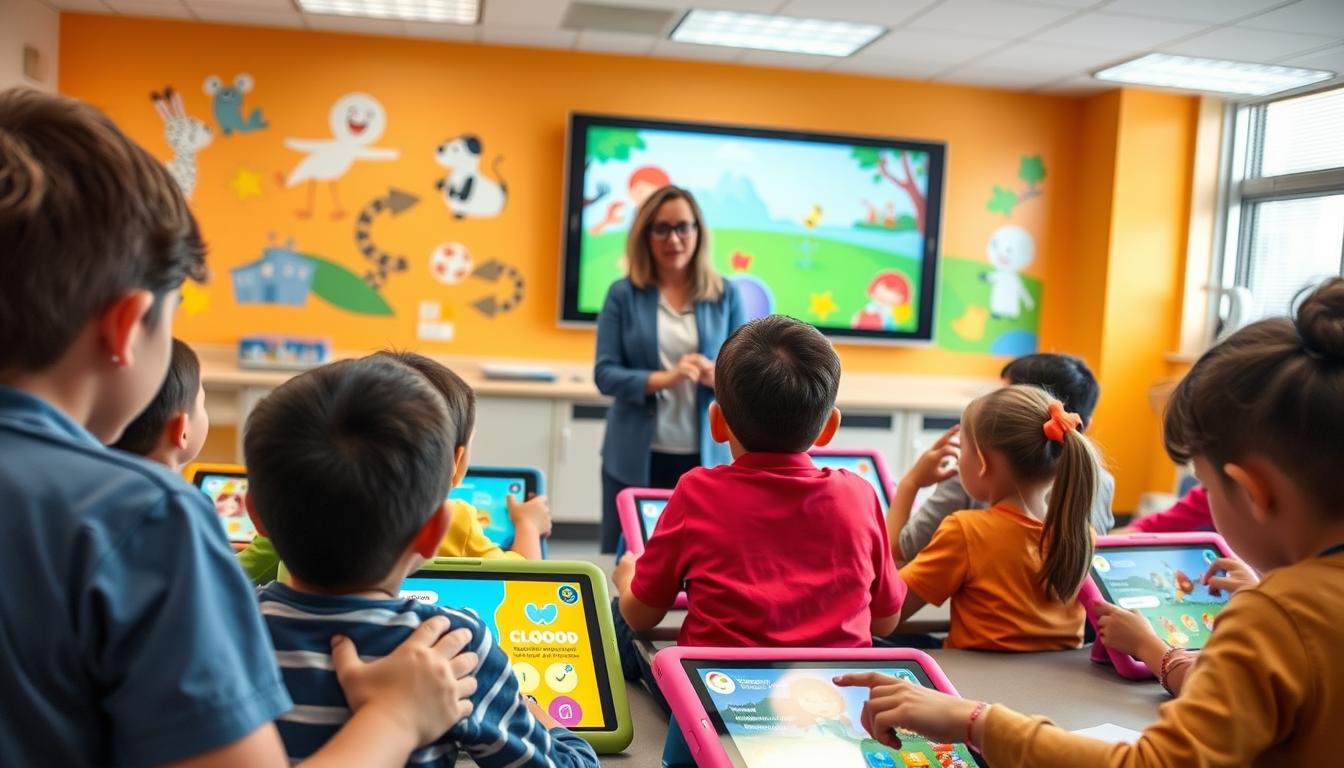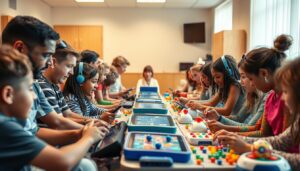Interactive games that teach conversational English using speech recognition
Have you ever thought about making learning conversational English fun? Interactive language learning has changed how we play ESL games. It makes learning not just effective but also fun.
Thanks to speech recognition technology, learners can have real-life conversations. This is changing the world of language learning games. They are expected to grow a lot in the next few years.
As learners dive into this new world, they get better at using English in real life. See how these interactive platforms are changing English learning for the better.
Introduction to Interactive Language Learning
Interactive language learning changes how we learn new skills. It makes learning fun and effective. Students dive into real-life language scenarios, making learning more engaging.
Techniques like gamification have changed the game. They turn learning into fun activities. This way, learners practice their skills in a fun way.
Personalized ESL strategies are key in this new approach. They meet the needs of all learners. With interactive tools, teachers can make learning fun and relevant for everyone.
This shift shows the need to keep up with technology. It creates a supportive environment for learners. Here, they feel motivated to become fluent.

The Rise of Language Learning Games
Language games have seen a big jump in popularity lately. This shows a move towards more interactive learning. The market is expected to grow by 6.4% each year. This growth shows more people want to learn languages through games.
Games for learning languages have many benefits. They give instant feedback, helping students see how they’re doing right away. This feedback boosts learning and makes it less stressful.
Playing educational games makes learning fun. It turns boring lessons into exciting activities. This makes students more motivated to learn.
Games add real-life context to learning. They help improve vocabulary and speaking skills. They keep students interested for longer, helping them remember what they learn.
Teachers are now seeing the value of using games in class. They help students become more fluent in languages. Games are becoming a key part of teaching.
Benefits of Using Speech Recognition Technology
Speech recognition technology makes learning languages easier. It gives learners instant feedback, which is key for good communication. This feedback helps students improve their pronunciation as they practice speaking.
It also lets learners see their strengths and what they need to work on. This helps them understand their progress better.
Another big plus is the chance for real-time interaction. This makes learning more engaging and boosts confidence in speaking. Students can get closer to sounding like native speakers by practicing rhythm and intonation.
Moreover, speech recognition makes learning personal. Everyone can learn at their own speed, focusing on what they find hard. This way, learners can really get to know the language they’re studying.
Engaging Conversational English Games with Voice Input
Learning a new language can be fun with engaging games. Voice input games are a hit because they mix fun with learning. They offer a wide range of activities, from building vocabulary to having real-time conversations.
Types of Games for Learning
Many games use voice input to make learning more exciting. Here are a few examples:
- Vocabulary Bingo: It’s a fun way to learn new words. Players listen for words and mark them on their cards.
- Charades: This game makes you talk about words or phrases. It helps improve speaking skills and creativity.
- Mad Libs: It’s a fill-in-the-blank game that sparks imagination. It also helps learners understand grammar better.
How Voice Input Enhances Learning
Voice input technology makes learning more interactive. It lets learners speak directly to the app. This way, they get instant feedback on how they sound.
Players can fix mistakes and get better at speaking. As they tackle different challenges, they become more confident. This makes learning both fun and effective.
Top Interactive Games for Teaching English
Interactive games are key for teaching English. They make learning fun and engaging. The best ESL games mix fun with learning, making language acquisition enjoyable.
Overview of Popular Choices
“Khayl,” “Kloo,” and “Bananagrams” are top ESL games. “Khayl” uses stories and role-playing to improve speaking skills. “Kloo” lets players build sentences with cards, boosting vocabulary.
“Bananagrams” tests quick thinking and spelling. These games are great for learning English.
Game Mechanics That Foster Engagement
Game mechanics make learning exciting. Competition pushes students to get better. Points and levels challenge them.
Working together helps build teamwork. Timed games and creative tasks keep students involved. These features make learning fun and effective.
How Games Improve Pronunciation and Listening Skills
Games are key in boosting both pronunciation and listening skills. They create fun settings for learners to hone their language abilities. Many games include pronunciation tests that help players speak words right and get feedback instantly.
Listening skills get a big boost from games with sound clips and stories. By doing listening quizzes, learners get better at understanding spoken words. This makes it easier to catch what native speakers say in everyday life. Games make learning hard parts of language fun.
Games also help by repeating certain phrases or sounds. This repetition helps learners pick up on small details. It makes remembering words easier and boosts confidence in speaking.
As players tackle different challenges, they learn important communication skills. This practice is key for speaking well.
| Game Type | Focus Area | Benefits |
|---|---|---|
| Pronunciation Challenges | Pronunciation Practice | Improves articulation and clarity of speech |
| Listening Quizzes | Listening Comprehension | Enhances ability to understand diverse accents |
| Interactive Narratives | Language Skill Development | Increases vocabulary through contextual learning |
This mix of fun and meaningful practice is great for learning language skills. It makes mastering language both enjoyable and effective.
Using Technology for Natural Communication
Technology has changed how we learn languages. Digital tools let students practice English in real-life settings. Apps like Rosetta Stone and games like WonderLang make learning fun and interactive.
These apps help learners talk in real situations. They get to use their language skills in practical ways. This makes them more confident and fluent.
Using these tools in school makes learning better. Students get feedback right away, helping them improve fast. This keeps them interested and helps them use the language every day.
Creating a Fun Learning Environment
Creating a fun learning space is key to learning new languages. An engaging classroom makes students want to join in. Games and interactive tools make learning exciting. Themed activities and competitions make the classroom feel like a community.
Using fun learning methods helps reduce language learning stress. When students enjoy learning, they practice more. Fun tasks help them remember language rules while keeping learning fun.
Here are some ways to make your classroom more engaging:
| Strategy | Description | Benefits |
|---|---|---|
| Themed Activities | Use topics students love, like pop culture or holidays. | Makes learning more relevant and fun. |
| Competitions | Host friendly contests that use language, like spelling bees. | Encourages teamwork and healthy competition. |
| Playful Learning Tasks | Use role-playing to practice speaking. | Improves retention through hands-on learning. |
Creating a fun learning space boosts motivation and makes learning a fun journey. As students use these strategies, they’ll grow more confident and skilled in the language.
Best Practices for ESL Teachers
Using games and technology in teaching ESL needs careful planning. Teachers should mix old teaching methods with new games. This mix helps students learn in different ways, making learning fun and engaging.
It’s important to teach differently for each student’s level. Teachers should change games and activities to help all students succeed. This way, every student can learn at their own pace, which is good for their growth.
Checking how students are doing is key. Teachers should use tests to see how students are improving. These tests help teachers know what to change in their teaching. They also make learning fun by adding games to the tests.
Being flexible and creative in teaching makes learning better. Adding real-life examples to games makes learning more meaningful. This encourages students to explore and learn more on their own.
Combining Traditional Methods with Technology
Blended learning is a big step forward in teaching languages. It mixes old teaching ways with new tech to make learning fun and effective. This mix helps students learn in a way that’s both engaging and thorough.
Old teaching methods give a solid base for learning a language. But, new tech adds excitement and keeps students interested. For instance, learning verb conjugations can be made fun with interactive games. This makes learning a language a joyful experience.
This mix of old and new teaching methods helps students practice in different ways. It makes learning stick better and boosts their confidence. As teachers keep improving, this blend of old and new is changing how we learn languages.
Feedback Mechanisms in Speech Recognition Games
Feedback is key in making speech recognition games better. These games use advanced tools to give users instant feedback. This helps learners spot and fix mistakes in pronunciation and fluency right away.
Learning gets better with this method. Feedback in learning games makes students more active. They keep improving with each try. This way, learners see their skills grow steadily.
These games also keep users excited. The feedback is fun and interactive. This makes learners feel proud of their progress. It makes learning a new language more enjoyable and effective.
Conclusion
Interactive games with speech recognition have changed how we learn conversational English. These tools make learning fun and interactive. They help learners practice real-life conversations.
Looking ahead, technology will keep playing a big role in teaching languages. New games will offer personalized learning experiences. This will improve language skills and prepare students for global communication.
Interactive games are becoming more important for ESL education. Using modern technology makes learning more fun and accessible. This mix of fun and learning is shaping the future of language education.
FAQ
What are interactive language learning games?
Interactive language learning games are fun tools to help you learn English. They make learning a game through activities that feel like real-life conversations. They use speech recognition to help you learn better.
How do speech recognition technologies assist in language learning?
Speech recognition helps by giving you instant feedback on how you sound. It lets you practice speaking right away. This helps you get better at talking in English.
What are some examples of popular interactive games for teaching English?
Games like “Khayl,” “Kloo,” and “Bananagrams” are popular. They help you learn English through fun activities. These games make learning a team effort or a fun challenge.
Why are games beneficial for improving pronunciation and listening skills?
Games make practicing easier and less stressful. They offer chances to try again and again. This helps you get better at speaking and listening.
How can technology improve natural communication for language learners?
Technology lets you practice talking in real-life situations. It makes learning English more relevant and fun. You can have real conversations with apps and platforms.
What strategies can ESL educators use to create a fun learning environment?
Teachers can make learning fun by using games and activities. This approach boosts motivation and reduces stress. It makes learning English a joyful experience.
How can traditional methods complement interactive gaming in language education?
Mixing old-school teaching with games creates a great learning mix. It offers structure and fun. This approach keeps students engaged and learning.
What role does feedback play in speech recognition games?
Feedback is key in speech recognition games. It helps you spot and fix mistakes. This way, you learn and improve with each try.














